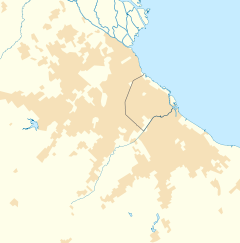Merlo, Buenos Aires
| Merlo | |
|---|---|
 |
|
| Location in Greater Buenos Aires | |
| Coordinates: 34°39′S 58°43′W / 34.650°S 58.717°W | |
| Country |
|
| Province |
|
| Partido | Merlo |
| Founded | August 28, 1755 |
| Elevation | 16 m (52 ft) |
| Population (2001 census [INDEC]) | |
| • Total | 244,168 |
| CPA Base | B 1722 |
| Area code(s) | +54 220 |
Merlo is the head town of the eponymous partido of Merlo and seat of the municipal government, located in the Greater Buenos Aires urban area of Buenos Aires Province, Argentina.
The city was founded by Francisco de Merlo in 1755 and rebuilt by Juan Dillon in 1859.
Merlo is divided in two distinctive regions: Merlo Centro, a middle class district clustered around the train station; and the working class barrios, most of them along the Reconquista River.
The administrative and commercial center is around the main avenue, Avenida del Libertador General San Martín. This tree-covered avenue stretches seven blocks from the railway station to the historic district and has few buildings reaching over two storeys in height.
Merlo is bordered by Moreno and Paso del Rey—both cities in Moreno Partido—and the Reconquista River (northwest), San Antonio de Padua (north), Libertad and Parque San Martín (east) and Mariano Acosta (south).
The origin of Merlo goes back to the town of Villa San Antonio del Camino, a hamlet clustered around a ranch-house belonged to the Spanish landlord Francisco de Merlo and which had been founded as a result of the recurrent Araucanian raids throughout the 18th century.
Francisco Javier de Merlo y Barbosa was born in Seville, Spain, on August 11, 1693 and died in Buenos Aires on April 4, 1758. Merlo arrives to Buenos Aires in the early 18th century and made a fortune and became part of the Buenos Aires upper class; Merlo served as notary public in the municipal government or cabildo of Buenos Aires. He also was a laity member of the Third Order of Our Lady of Mercy. He married Francisca del Toro in 1713 and they had eleven children. After widowed he married María Teresa Gamiz de las Cuevas in 1748, who gave him a son.
...
Wikipedia

